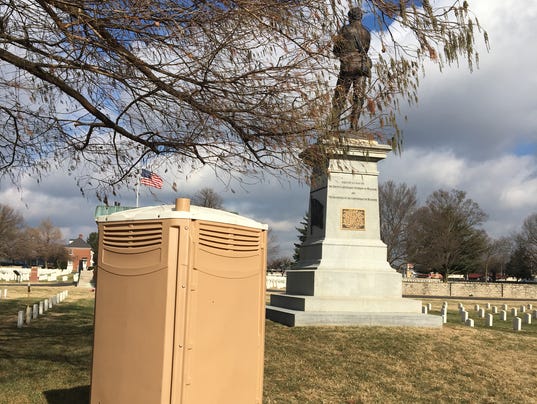Springfield Confederate monument still guard 24/7/365
Springfield MO July 3 2018 A private security firm hired last summer to protect a Confederate monument at Springfield National Cemetery is still on the job 24/7.
I visited the cemetery Wednesday afternoon and noticed that a security car was still in the cemetery, near the monument. Only the port-a-potty had been moved.
In December, the port-a-potty had been closer to the monument. Now, it is mere inches from the passenger side of the car.
I don’t know why it is so close, but I wondered if it was moved to make it more difficult for some young hooligan with low self-esteem to tip it over.
But the security guard was not in the marked security vehicle.
Instead, he was nearby in his own personal car.
He told me he worked for the Whitestone Group, a national private security firm based in Columbus, Ohio.
I had already deduced that by reading the patch on his shirt.
He told me he lives in Nixa and that Whitestone is still providing around-the-clock surveillance on the monument.
On the base of the Confederate monument is the likeness of Confederate Major General Sterling Price, 11th governor of Missouri, a former slave state. He was governor 1853-57.
On another side of the base is the likeness of a Confederate flag and the words: “They fought for the right of self government.”
Many of the Confederate soldiers buried here died in the battle of Wilson’s Creek on Aug. 10, 1861. Union soldiers are buried nearby, as well as veterans from other wars.
The monument, constructed in 1901, was vandalized in the late evening of Aug. 29 or early morning of Aug. 30.
If you recall, the display of Confederate monuments and statues was hotly debated last summer.
Several Confederate statues across the nation were either vandalized or removed from public view.
For example, a statue of Roger Brooke Taney, who is the namesake of Taney County, was removed from the statehouse lawn in Annapolis, Maryland.
Confederate statues of Taney, Robert E. Lee and Stonewall Jackson had already been quietly removed in Baltimore.
At an Aug. 13 rally in Charlottesville, Virginia, a woman was killed.
A “Unite the Right” rally of white nationalist and other right-wing groups had been scheduled to take place in the city. The woman died and 19 others were hurt when a speeding car slammed into a throng of counter-protesters.
The Confederate monument in Springfield was built inBuy Photo
The young security guard in the car told me the unoccupied security vehicle nearby was low on gas and that he had permission to use his own car.
I asked if he could tell me his name.
“Negative.”
Next, I went to the nearby office of Gary Edmondson, the cemetery’s administrative officer.
This was the third time I have visited his office to ask the question: How long is the contract for security and how much is this costing the federal government?
For the third time, he told me I would have to talk to someone higher up the chain in the federal government.
But I did get one question in: Since December, has there been any vandalism to the monument or any thwarted attempts of vandalism?
“No,” he says.
When I got back to my car, it occurred to me I’d been down this path before regarding the cost of security.
In fact, I had filed a Freedom of Information request with the U.S. Department of Veterans Affairs.
On Jan. 16, I’d asked for “copies of contracts dated Sept. 1, 2016 to Jan. 10, 2018, between the VA and a company called Whitestone Group, based in Columbus, Ohio.”
I don’t know how many Confederate monuments there are on federal property. And I don’t know how much money is being spent to keep an eye on them.
But I’m starting to believe — based on what’s happening in Springfield — that it’s a ton of money.
The VA got back to me Feb. 12 and said the records I sought are at the James A. Haley VA Hospital, which is in Tampa, Florida, and that my request has been forwarded to Jeffrey D. Wilkinson, in Albany, New York.
I also received a copy of a letter Wilkinson had sent to the Whiteside Group, informing the company I had requested the contracts and that there is an exemption to disclosure if the release of the information would cause Whiteside “competitive harm.”
Wilkinson also wrote this to the company: “I cannot rely on a merely conclusory assertion of possible competitive harm. I need to understand exactly how the FOIA (Freedom of Information Act) requestor could use the disclosed information to create a significant harm to your company’s commercial interests.”
The company had 10 working days to make its case to Wilkinson on whether disclosure would cause competitive harm.
To be honest, I did not follow up.
Until Friday. I left a phone message for Wilkinson and sent him an email.
news-leader




